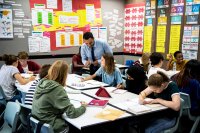Intention-Setting in the Classroom
Asking middle school students to focus on their guiding principles can lead them to more productive individual and group work.
Intention-setting—a powerful mindfulness practice rooted in a rich contemplative history—is becoming a popular tool for supporting the personal and professional development of adults. Can it be used in the classroom in a way that supports student learning?
Intention-setting, it’s important to note, is different from goal-setting. Goals are clear targets that we strive to hit. For example, a student may articulate the goal: “By the end of class, I will have brainstormed several possible designs and decided which one I’m going to build based on the given criteria.”
Intentions are guiding principles that can help us, as individuals, connect our present actions to our personal values. They focus on who we are and who we could be in this moment. For example, “I want to be a more empathetic (or hard-working, generous, etc.) team member” may be an intention that a student establishes before launching into a group work session.
Intention-setting can lead to more generative individual and group work because students create aspirational visions of themselves and the way they hope to be prior to engaging in the work. When a student sets the intention to be more empathetic, diligent, generous, or in tune with the needs of their teammates, they’re also setting the stage for more fruitful collaboration.
As educators co-teaching an elective course at a local middle school, we’ve been enjoying experimenting with intention-setting in our classes. We work to integrate mindfulness practices into a project-based learning curriculum to support students’ social, emotional, and academic development. In each class, we give students three minutes to set a guiding intention for the upcoming activity, and then five minutes at the end of class to reflect on the ways in which they lived their intention.
This intention-setting protocol is still very much a work in progress; however, in the process of refining it, we’ve identified some considerations that we’ve found helpful to think through.
Key Aspects of Intention-Setting
Invite students to set an intention at the beginning of every class or activity: Intentions are most effective when they reflect who we are and who we want to be in the present moment. Therefore, student choice is critical. For a given activity, students may choose the same intention they’ve been working on all week or commit to a different one. The point is that they have time to reflect on and articulate an aspect of the person they intend to be during class.
Consider providing scaffolds: Many students struggle to distinguish between intentions and goals. For example, a student might say to their group, “Let’s finish on time!” That’s a worthwhile goal, not a personal intention. Intention-setting requires students to consider the personal commitment that they’re interested in making. Perhaps this student could set the intention to be fully present, to serve as a strong facilitator, or to exercise patience with their teammates.
One way we’ve tried to support students is by offering a list of possible intentions. While this can be helpful, there’s a danger that students will simply copy these intentions without thinking deeply about them.
Check in with students throughout the class period or activity: Use students’ personal intentions as a tool to (re)focus their work, by asking them what their intention is and how they’re living it in that moment. A quick check-in with a student can be more powerful and effective when it is oriented around a personal intention that the student has set for themselves, rather than an extrinsic goal or motivator.
For example, a teacher might say, “I know that you set an intention to be a deep listener, especially when your team is exploring a disagreement. How are you leaning in to that intention?” Check-ins like this encourage in-the-moment reflection—reflection doesn’t need to happen only at the end of the period.
Consider implementing peer feedback: The question of whether students should share their intentions with each other and get feedback on how well they lived their intentions depends on several factors, including your students, your goals, and your classroom context. Intentions can be deeply personal—e.g., “I intend to be more assertive (or confident, humble, etc.).” If students know they’ll have to share their intentions with their teammates, they might choose intentions that represent less vulnerability and are thus less meaningful to them.
Asking students to provide constructive feedback to one another requires strong classroom norms and scaffolds, but according to psychologist Daniel Goleman, feedback is essential for developing self-awareness. Therefore, this is an important question for educators to explore.
Make time for students to reflect at the end of class: Giving students an opportunity to reflect at the end of class can create an iterative cycle that helps them become more self-aware. Powerful learning can result when students set an intention, practice that intention, and then reflect on how well they were able to live their intention. This reflection can also help inform the intentions that students choose to set for themselves in subsequent classes: Based on how well they were able to live their intention and the impact that had on them, their groups, and their work, students may add nuance to their intention or choose an entirely new one in the next class.
